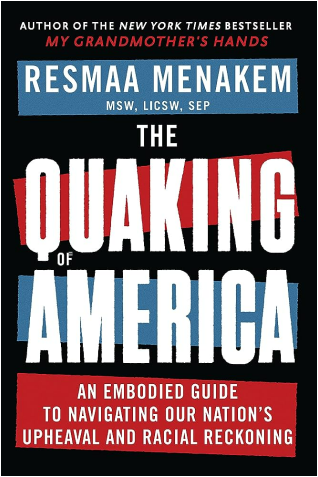For the past three decades, we’ve earnestly tried to address white-body supremacy with reason, principles, and ideas — using dialogue, forums, discussions, education, and mental training. Clearly, this isn’t working as well as we’d expected.
It’s not that we’ve been lazy or insincere. But my experience as a therapist tells me that we’ve focused our efforts in the wrong direction. We’ve tried to teach our brains to think better about race. But what if white-body supremacy doesn’t live in our thinking brains? What if it lives and breathes in our bodies?
Our bodies have a form of knowledge that is different from our cognitive brains. This knowledge is typically experienced as a felt sense of constriction or expansion, pain or ease, energy or numbness. Often this knowledge is stored in our bodies as wordless stories about what is safe and what is dangerous.
The body is where we live. It’s where we fear, hope, and react. It’s where we constrict and relax. And what the body most cares about are safety and survival. When something happens to the body that is too much, too fast, or too soon—and we don’t get enough safety or regard—it overwhelms the body and can create trauma.
Contrary to what many people believe, trauma is not primarily an emotional response. Trauma always happens in the body. It is a spontaneous protective mechanism used by the body to stop or thwart further (or future) potential damage.
Trauma is not a flaw or a weakness. It is a highly effective tool of safety and survival.
Trauma is also not an event. Trauma is the body’s protective response to an event—or a series of events—that it perceives as potentially dangerous.
An embedded trauma response can manifest as fighting, fleeing, freezing, fawning, or annihilating—or as some combination of constriction, pain, fear, dread, anxiety, unpleasant (and/or sometimes pleasant) thoughts, reactive behaviors, or other sensations and experiences. This trauma then gets stuck in the body—and stays stuck there until it is addressed. Our rational brain can’t stop it from occurring, and it can’t talk our body out of it.
Trauma can cause us to react to present events in ways that seem wildly inappropriate, overly charged, or otherwise out of proportion. Whenever someone freaks out suddenly or reacts to a small problem as if it were a catastrophe, it’s often a trauma response. Something in the here and now is rekindling old pain or discomfort, and the body tries to address it with the reflexive energy that’s still stuck inside the nervous system. This is what leads to mobilized over-the-top or immobilized, underpowered, thwarted reactions.
In many cases, the body gets stuck in freeze mode, and then develops strategies around this stuckness, including extreme reactions, compulsions, strange likes and dislikes, seemingly irrational fears, and unusual avoidance strategies. Over time, these can become embedded in the body as standard ways of surviving and protecting itself. When these strategies are repeated and passed on over generations, they can become the standard responses in individuals, families, communities, and cultures.
All of this describes trauma in general—and white-body supremacy in particular.
We’ve been dealing with white-body supremacy as if it’s an attitude, a conviction, a belief system, or a way of seeing the world—as if it lives in the thinking brain. But, in my two decades as a therapist, I’ve come to see that this is a myth.
White-body supremacy—and all the claims, accusations, excuses, and dodges that surround it—are a trauma response. This response lives not inside psyches, but deep within bodies. The attitudes, convictions, and beliefs of white-body supremacy are reflexive cognitive side effects, like the belief of a claustrophobe that the walls are closing in. These ideas have been reinforced through institutions as practice, procedures, and standards.
We already know that what we’ve been doing to counter white-body supremacy isn’t working. If we are to upend the status quo of white-body supremacy, we must take a different approach. We — and by “we” I mean people of all skin tones, but especially folks with white bodies— need to begin with our bodies, and with the healing of our trauma.

